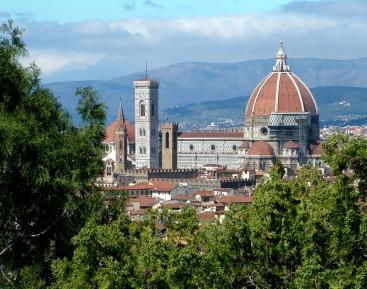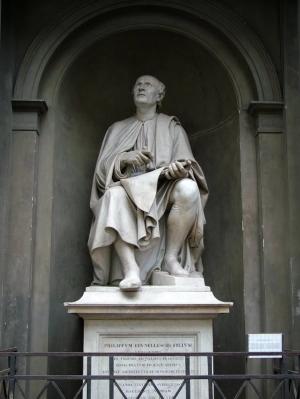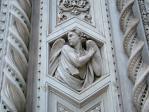CATHEDRAL SANTA MARIA DEL FIORE
HISTORY OF THE CATHEDRAL SANTA MARIA DEL FIORE. The Cathedral dates from 1294 and is known by Florentines as the Duomo. It is the third largest church in Italy and an example of Italian Gothic architecture. The cathedral was built on the site of the crumbling mediaeval church of Santa Reparata. The title ‘fiore' (Italian for flowers) refers to the lily which features on the Florentine coat of arms.

A stylised red and white lily is the official emblem of Florence.
In the 13th century, a levy was raised on wealthy Florentine merchants and guilds to pay for the construction of the new cathedral so it would be a status symbol for the city and demonstrate to the rest of Italy the wealth and importance of Florence.
FIVE GREAT ARCHITECTS were involved with the construction of the cathedral. The huge edifice took over a century to complete and five architects worked on various aspects of the design and supervised the construction. The original architect, Arnolfo di Cambio, created the conceptional designed and supervised the laying of the foundations. After his death, Giotto, the Master of Works, supervised the early stages of the cathedral's construction. When he died as well Andrea Pisano took over from Giotto. Eventually Pisano was replaced by Francesco Talenti. The final architect was Giovanni Ghini who lived long enough to see the cathedral consecrated.

Floorplan of Sta. Maria del Fiore
The size of the cathedral is impressive, even by today's standards. The interior area measures 8,300 sq metres (89,000 sq feet) and was intended to accommodate over 20,000 worshippers. The building is 169 metres long (526 feet) and central part of its roof is supported by six gigantic stone columns.
Near the Porch of the Canons in the interior are memorials to two of its architects who are buried here — Arnolfo di Cambio who designed it and Filippo Brunelleschi who created the famous dome which is visible all over the city has become a symbol of Florence in the eyes of the world.

Brunellischi's Dome
FILIPPO BRUNELLISCHI'S DOME. The cathedral took over a century to build but still lacked a dome or marble cladding to the stone façade. The Florentines despaired of finding an architect able to complete the enormous edifice with a dome, which had to span 45 metres (138 feet) and would be larger than the dome of Istanbul's Hagia Sofia or that of Rome's Pantheon built by the ancient Romans.
Filippo Brunelleschi had been apprenticed to a goldsmith at a time when there was no such thing as a university degree in architecture. He was angry and disappointed when in 1401 he did not win the competition to design the doors of the Baptistery. An ambitious young man, Brunelleschi (according to the Renaissance art historian Vasari) went to Romes accompanied by young Donatello. Brunelleschi wanted to study the dome of the Pantheon hoping to understand how the Roman builders had constructed such an enormous dome, without scaffolding so he could repeat their feat of engineering in Florence.
Returning to Florence, Brunelleschi, who had basic knowledge of engineering, insisted he had discovered how the Romans had built their dome without the use of expensive internal scaffolding and support system. He proposed to build a dome for the Santa Maria del Foire on the same principle, but refused to reveal how he intended to do it.
Brunelleschi and Ghiberti again became contestants in a competition to build the cathedral's dome. Vasari related how the two rivals were asked how they would build such a large dome. Brunelleschi explained to the interviewing committee that, if he revealed his construction method, Ghiberti would steal his idea.
When the committee ridiculed him, Brunelleschi produced an egg from his pocket and challenged Ghiberti and the committee members to make it stand on end. They all claimed that this was impossible, but Brunelleschi was able to do it after cracking the tip of the egg. The members of the committee protested and claimed they could easily have done the same. Brunelleschi retorted that this was exactly what they would have said if he had revealed his method of building the gigantic dome. He won the competition and the dome he built made him famous.
Brunelleschi built an outer and inner dome of bricks which interlocked by placing them in a herring bone pattern, the same technique employed by the Romans when building the dome of the Pantheon. Brunelleschi used external scaffolding, which was supported by poles, inserted in holes in the completed base of the dome. When the next part of the dome was completed, poles were placed in a higher row of holes, allowing the scaffolding to be raised. This process was repeated until the complete dome had been built. A distinctive lantern-like feature is crowning the dome. The holes for the poles that supported the scaffolding are still visible.
Brunilleschi's dome measures 114 metres (375 ft) high and it was finished on 25 March 1436, on the Feast of the Annunciation and consecrated by the current Pope. Via long flights of stairs, located between the inner and outer dome, it is possible (but very tiring) to climb to the top for a panoramic view of the city.
THE MARBLE FRONTAGE. It took another 400 years after the cathedral was consecrated to raise the money to cover the front in an ornate marble cladding designed by Emilio de Fabris in 1875. This new and intricate façade repeated the colours of the marble cladding on Giotto's elegant bell tower. Pic from Inside Florence??
Work on the carvings and intricate geometric patterning of the marble following the design of de Fabris took skilled craftsmen 12 years to complete and it was finally finished in 1887. Three different marbles were used — , white marble from Carrara, dark green marble from a quarry at Prato and the reddish pink marble from Tuscany's Maremma district. Niches were designed for statues of the Four Apostles, several Florentine bishops and a statue of Pope Eugene IV.
Many people wished to have Michelangelo's David hoisted up the face of the cathedral and placed it in one of the niches, as the David represents Florence as an emblem of liberty against tyrants. Due to the enormous weight of the statue the project was abandoned. Instead Michelangelo's original marble statue was moved to the Accademia Gallery and replaced by an excellent copy outside the Palazzo Vecchio.



